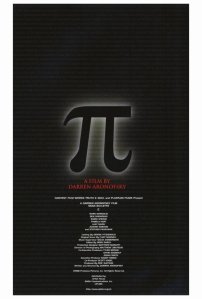
Written and directed by Darren Aronofsky
I am pretty certain that most people who enjoy certain movies entertain the notion of repeat viewings for those movies. Most people don’t say, “Wow, that was a fantastic movie, and I am never going to watch it again!” Anyone who has seen a Darren Aronofsky film, however, knows exactly what I’m talking about. Pi (1998) is Aronofsky’s first feature-length film, and his least scarring one.

Still a little scarring. It wouldn’t be Aronofsky without psychological scarring.
Max Cohen (Sean Gullette) is a mathematician obsessed with finding the key number that will unlock all the secrets of the universe, from nature to language to the stock market. Inspired by the Fibonacci Sequence, Max consults his friend, mentor, and former professor Sol Robeson (Mark Margolis) on the existence of this key number. Max encounters a mysterious number while writing a program to predict stock market fluctuations, which causes his computer’s motherboard to shut down completely. While delving deeper into this enigmatic number that seemingly holds so much power, Max meets Lenny Meyer (Ben Shenkmen), an Orthodox Jew and fellow mathematician. As Max discovers more about his mystery number, he also realizes that he is not the only one who wants their hands on the number.
Aronofsky is one of several apt masters of the psychological thriller genre. He is talented at viewer confusion, and a downright genius when it comes to stretching our minds to the breaking point of both logical understanding of the film’s universe and our internal sense of imagination. If you had to reread that sentence (like I did to make sure it was grammatically correct), a repeated view of Pi might be part of your near future.
Don’t be discouraged! This is not admittance of intellectual defeat or of stunted psychological cognition. It is merely evidence that Aronofsky is a fantastic storyteller in both writing and direction. Before the Fight Club (David Fincher, 1999) revolution that created the demand for twist endings in movies, not very many films were gritty in nature, nor did they offer viewers the luxury of having their minds blown. I have talked about this before, but I love films with ambiguous endings. I love movies where I go “What. The. Hell”, get mad for a week, go into a theory/analysis research spree, and then accept that the movie was fantastic.

My favorite reaction to movies ever.
So the plot is a tad bit hard to follow at times. What about non-narrative aspects of the film? Well, my dear internet friends, there is not much luck in the cinematography/color/lighting areas if you are looking for clarification. The film is shot in high-contrast black and white, a telltale sign of Aronofsky’s inspiration of German Expressionist films. In each shot of the film, the frames are both over- or under-exposed, casting harsh shadows and mostly eliminating detail from the characters and their surroundings. Although this can be frustrating at times, it allows the viewer to focus a little more on the plot.
Aside from Mark Margolis, who most notably (to me and other Breaking Bad fans) portrayed Tio Salamanca, the cast consisted of actors I am not familiar with. For many of the actors in Pi, this was their first major role in a feature film. Retrospectively, I think this was another good move on Aronofsky’s part; placing actors in the film who were recognizable in 1998 would have adversely affected the narrative flow by distracting viewers.
Pi does not necessarily have a distinct message meant for the viewer. It is not a clean ending by any means. However, it is a testament to the quality of independent and low-budget films. It is also a testament to quality thrillers in general. For those about to have their mind fried: it’s a glorious feeling. Embrace it.

I SAID EMBRACE IT.